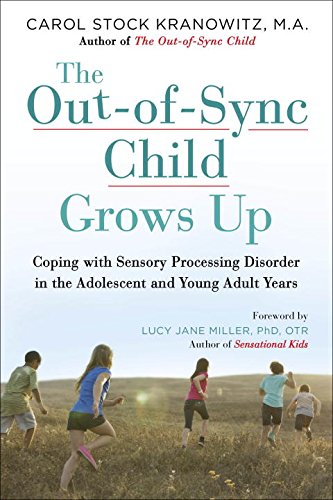Excerpted with permission from The Out-of- Sync Child Grows Up: Coping with Sensory Processing Disorder in the Adolescent and Young Adult Years by Carol Stock Kranowitz, M.A. © 2016 by Out-of- Sync Child, Inc. TarcherPerigee, an imprint of Penguin Random House.
Adolescents and young adults with SPD frequently feel uncomfortable or get “stuck” in sensory situations. One way to improve these situations is to get familiar with a problem-solving method that OTs and other therapists call “clinical reasoning.” This involves analyzing what’s happening inside and outside the teenager and then thinking of modifications.
![]()
Problem-Solving Using Dr. Lucy Jane Miller’s Method, A SECRET
At the STAR Center in Colorado, Lucy Jane Miller, PhD, OTR, has developed a problem-solving method called A SECRET. She lays it out in her book, Sensational Kids (revised, 2014), and, co-authored by Doreit Bialer in No Longer A SECRET (2011).
Lucy teaches parents, teenagers, and even young children to analyze seven elements in sensory or motor challenges and to suggest ideas that may lead to smoother functioning. This is a preventative approach.
“A SECRET” is an acronym for these seven elements: attention, sensation, emotional regulation, culture (including context and current conditions), relationship, environment, and task. A SECRET is not a rigid formula for what to do, but a flexible format for how to think about manipulating these elements.
First you choose one challenging area such as self-help skills. Then there are questions a parent (or whoever is involved) can ponder when a teenager is struggling with, say, the sensory-motor problem of getting dressed. Here is an example.
A = Can I do something to change my son’s attention to his problem? I could suggest that he search on-line for organic, fair trade, clothes that appeal to his interests, or for loose, soft, seamless items that meet his sensory specifications, to help him attend to what he wears.
S = Can I find a great sensory strategy? A morning back rub or rolling a therapy ball over him may get input into his skin and muscles to ready him to get dressed.
E = Can he do something to affect his emotional regulation in the moment? Perhaps playing his favorite upbeat music, or brightening (or dimming) the lighting in his room would get him in the mood to get dressed.
C = What could I change about the culture/context/current conditions? (This doesn’t refer to ethnic culture; it specifically focuses on how things are done at home or wherever the challenge occurs.) Dressing after breakfast, rather than before, may make a difference, or giving him the responsibility of doing a clothes-oriented chore like washing or putting away his own clothes.
R = Is there something about our relationship that I could use to motivate his dressing? Letting him wear what’s comfortable, and not telling him what looks best, may help him get dressed quickly. It may work to take him shopping on a quiet week-night and allow him to select new clothes.
E = What in our environment could I change? It may help to install hooks in his closet so he needn’t fuss with hangers, or to set up labeled bins (T-shirts, Socks, etc.), instead of a visually confusing jumble in a dresser drawer. A dressing schedule posted on the wall may be useful, too.
T = Can I add or subtract a task to change the situation? He could lay out his clothes the night before, or use a visual schedule and check off each item when he puts it on.
Implementing A SECRET takes a bit of practice, as do all worthwhile and life-changing endeavors. It can not only have a major impact on the teenager but also make school and family life much smoother. For example, you could take this idea to an IEP meeting and involve all the teachers in the problem-solving tasks. Or you could take it to Grandma’s before Thanksgiving dinner and get the family involved in ways to make the big gathering work for your teenager.
About The Out of Sync Child Grows Up
The long-awaited follow-up to the million-copy bestseller The Out-of-Sync Child, presenting information and advice for tweens, teens, and young adults living with Sensory Processing Disorder, and their parents.
The Out-of-Sync Child Grows Up will be the new bible for the vast audience of parents whose children, already diagnosed with Sensory Processing Disorder, are entering the adolescent, tween, and teen years, as well as those who do not yet have a diagnosis and are struggling to meet the challenges of daily life. This book picks up where The Out-of-Sync Child left off, offering practical advice on living with SPD, covering everyday challenges as well as the social and emotional issues that many young people with SPD face.
Topics include strategies for coping with the sensory aspects of grooming, social lives and dating, playing sports and music, and other issues, as well as how to find support and help from loved ones, occupational therapy, and other resources. Carol Kranowitz’s insights are supplemented by first-person accounts of adolescents and teens with SPD, sharing their experiences and hard-won lessons with readers and adding a powerful personal dimension to the book. Buy from Amazon.
Additional Autism Resources
Share This!
[social_warfare buttons=”Facebook,Twitter,Pinterest”]
![]()



